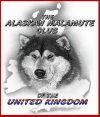The origins of the Alaskan Malamute
The Alaskan Malamute is the heaviest of the sled dog breeds. Built for strength, not speed, they hauled the sleds carrying the entire belongings of their nomadic owners across harsh, icy terrain for long distances and were invaluable to the lifestyle these people lived. They often slept outside in temperatures up to minus 50 degrees, their thick, woolly, double coats able to protect them from the harshest of winters.The breed standard we have today preserves the survival characteristics of the breed and mean that the dogs of today are still similar in looks to the sled dogs in photos from the late 1800s.
The Malamute breed is named after the Mahlemut tribe of nomadic Inuits who lived in Alaska between the Noatak and Kobuk rivers and has origins dating back a couple of thousand years. The dogs were central to the lives of the tribe, being used to haul belongings or equipment by sled during the winter or carrying backpacks during the short summer season. They were also used as hunting dogs, searching out seal holes in the ice, or distracting bears for the hunters. Never a one-man dog, they were happy around all tribe members, but the limited food source gave them a high prey drive, keenly hunting anything that came too close to camp and as keen to fight other dogs for their catch. As a breed, the Malamute still requires less food quantity than other large breeds to maintain a healthy weight and whilst the urban domestication has certainly led breeders to concentrate on improving temperament, these primitive traits are certainly still relevant to the breed today. That said, they lived in small packs and were often said to be taken inside the dwelling to sleep with the children to keep them warm and whilst they were never a guarding breed, they would alert the tribe to any danger from roaming bears or wolves.
The breed remained quite pure until the Gold Rush. In 1890 in Klondike gold was found and many people travelled to Alaska to make their fortune. This led to dogs being bought in large numbers to carry equipment but also to them being bred to other large breeds to create more powerful looking dogs such as St Bernards. As a consequence, this led to a higher mortality rate as the mixing of breeds reduced the pure Malamute’s ability to survive in the harsh winters. This period had a devastating effect on the pure Malamute dog and whilst there were some dogs that retained the look and characteristics of the Malamute, there was clearly little evidence of the pure Alaskan dogs.
Move forward to 1928, when Mrs Eva “Short” Seeley and her husband Milton managed the Chinook kennels in New Hampshire, USA for its owner Arthur Walden while he was on the first Byrd Antarctic Expedition. On his return in 1929, the Seeleys purchased the kennels from Walden and Eva started breeding Siberian huskies and Alaskan Malamutes. Whilst it is generally accepted that her foundation stock was not pure Malamute, she bred the first test litter in 1929 and was successful in officially recognising the breed with the American Kennel Club in 1935, the first registered Malamute being Rowdy of Nome, the dog that Eva considered to be her ideal dog. In that first litter was Gripp of Yukon who went on to become the first Champion Alaskan Malamute. By breeding to type and registering only litters who demonstrated a uniform look, or individual puppies who met Eva’s ideal Malamute, she was able to develop a line and decided on the kennel name of Kotzebue.
All dogs registered before 1950 were of Kotzebue, or descended from, Kotzebue breeding but there were claims from other breeders that they were not the only Malamute dogs. Paul Voelker was breeding his own type of “malemute” from the late 1920s and whilst the Seeleys’ dogs were always grey, the Voelker “M’Loot” type introduced other colours due to his wider foundation stock. The third strain was the Hinman/Irwin strain. Dick Hinman and Dave Irwin started breeding from dogs brought back from the Gold Rush. Whilst this strain followed the same general look as the other two, they were a bigger dog and quite impressive with bigger coats. This third strain was championed by Robert Zoller (Husky-Pak) who fought hard against Eva Seeley to amend the breed standard to accept the other strains.
By 1950 there was a major decline in the number of Malamute registrations. The Seeleys were supplying dog to the American army during World War Two and it was protocol for the dogs to be destroyed at the end of the war, leaving too few dogs to sustain the breed. When the stock fell to under 30 dogs, the AKC re-opened the stud book to allow registration from the other strains and from then the breed started to evolve into the dogs we know today, with many owners mixing the different strains. The one dog that unites all of these lines is Ch Toro of Bras Coupe. He represented the breed for many years in the AKC Complete Dog Book. Toro is behind every Malamute alive today because of his use in blending all three Malamute strains.
Mike John – Cristakell Malamutes
